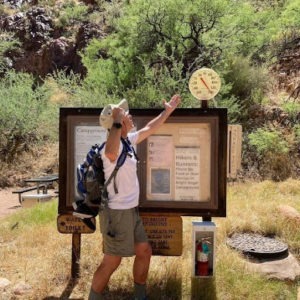One sign at the top of North Kaibab trail to the Grand Canyon warns: “Hiking down is optional. Hiking up is mandatory.” A second sign nearby ominously cautions that the National Park Service does not recommend anyone attempt to hike from one rim of the Grand Canyon to the other. It’s no exaggeration to report that people die every year hiking in the Grand Canyon. It’s harsh. It can be intolerably hot, sucking the energy from anyone attempting to hike in temperatures that can reach well above 120 degrees. As one blogger famously put it in a warning letter, it’s like a marathon, except that unlike a “comfy marathon” if you get sick, or exhausted, or want to quit, or you twist an ankle or your knee gives out, you can’t call a taxi to take you back to your hotel. No one is coming to get you. “You are your own rescue.” https://www.r2r2r.org/jeans-annual-warning-letter Hiking out is mandatory.
The rim to rim, or R2R is a through hike from one rim of the Grand Canyon to the other. Although it can be accomplished in a few days by camping or staying overnight in cabins at Phantom Ranch, the real test of R2R is accomplished in a day. One. Long. Day.
Because R2R is a grueling test, covering more than 26 miles and 12,000 feet of elevation change, the beginning of the hike actually starts months before the day you have selected to go. You will need to be in great shape. It’s recommended you build up hiking or running to comfortably completing at least 10 miles multiple times before you go. Many people use training protocols published for marathons. That’s a good way to prepare. Don’t underestimate how hard it is, or that you need to be in great shape and able to hike for half a day.
The list of necessities is fairly simple: really good shoes (boots are not needed. Tennis shoes or trail runners are great). TWO PAIR of great socks. A hat. Sunglasses. Sunscreen. A headlamp, as it is likely you will either start or end your hike in the dark. A hydration pack with at least a 2L bladder and some room for light salty snacks…nuts, chips, nutrition bars. An apple. Raisins. Keep it light. Someone in the group should bring a first aid kit.
Logistics: the North Rim is significantly higher (1300 feet!) than the South Rim. The few who attempt R2R in a day recommend hiking north to south for that reason. Hiking south to north leaves the greatest elevation for last. That is like deciding to add climbing a 130 story building after hiking more than 20 miles.
You should plan to stay at or near the North Rim. There is lodging at the North Rim which has to be reserved well in advance. https://www.grandcanyonforever.com/ There is lodging just outside the park gates (https://kaibablodge.com/ ) Jacob Lake (https://www.jacoblake.com/ ) or Kanab, 75 miles away.
You will need to either arrange for someone to drop you off at the North Rim and drive your car around the canyon to the South Rim to pick you up on the South Rim, or hire a shuttle to return you to your car. While the distance straight across is about 12 miles, the drive from North Rim to South Rim is 220 miles and takes about 5 hours. Shuttles can be booked in advance at https://www.trans-canyonshuttle.com/, or at the Kaibab Lodge, listed above. Your only other option is to hike back to your car, thus performing the rare R2R2R!
It is estimated the hike will take between 12 and 15 hours. Unless you begin before sunrise, and many do, the hike will likely end just before or after sunset. Hotel rooms on the south rim are expensive, must be booked months in advance, but are a singularly spectacular experience. Several restaurants are available on the south rim.
One consideration that is critical is when to go. The North Rim is typically closed by snow, owing to elevation of 8803 feet, from November 1 until the second week in May. In summer the hike is dangerously hot. I’m pictured here on June 18 at Phantom Ranch, near the Colorado River. The temperature was over 130degrees Fahrenheit! It was a mistake to hike in that temperature.

The recommended times are between May 15 and June 15 or September 15 until November 1. It’s not only not recommended, it’s just not safe to try a R2R hike between July 1 and September 1. But for a R2R hike, daylight becomes an issue later in the year, although the cooler weather in the fall is pleasant. Unless you are running R2R, and a handful of ultra trail runners do, you will want to leave at first light (or before) and expect to finish at sunset or after.
The Hike: Starting at the North Kaibab trailhead, a couple of miles from the North Rim Lodge, you can expect that the temperature will be cold at dawn, even in June. It’s not at all unusual to find a difference of more than 50 degrees from that point to when you reach Phantom Ranch, 13 miles later.
Although you eventually drop more than 6500 feet, there are few truly steep downhill places. The trail is, for the most part, gradually downhill. The dirt is beaten flat by years of hikers and daily mule teams which carry supplies to Park Service outposts and Phantom Ranch, and garbage and mail out. There are some steps built in by rock or logs to prevent erosion, but no difficult climbing or scrambling is necessary.
While the hike is a test, don’t forget to enjoy it and appreciate being in one of the most spectacular places on earth. The vistas are incredible. The colors change with the changing light. Each corner in the trail presents a new wonder. The power of nature carved this out over centuries of time. Amazing. Incomparable.
Water is available most of the time every two or three miles. There are breakdowns that occur to the system of pipes carrying water from underground springs and creeks. Hikers are well advised to fill up at every opportunity, and to check with the National Park Service website to determine whether there are known breaks in the water system. Given the heat and the strenuous activity, being able to access water every two or three miles is about right. But a disruption in the water system stretches that to four to six miles, and careful rationing is necessary.
Hydration is key to a successful hike. The heat is relentless. Very little shade. It’s physically strenuous beyond anything most people ever experience. It’s a good idea to hydrate the day before the hike. Keep it going throughout the day of the hike. I’ve seen people who failed to hydrate sitting by the side of the trail, 5 miles from the top, staring straight ahead, looking as if they were completely spent.
The first half of the day is all downhill. From North Kaibab trailhead to Phantom Ranch is 14 miles. Most people stop there to rest in the shade, and many try the famous lemonade. A pro insider tip, however, is to walk a little farther down the creek towards the Colorado river. Where the trail crosses the creek heading up Bright Angel trail, just before the river there is a great restroom, and the creek is cold and makes for a beautiful place to rest. While the area around the canteen at Phantom Ranch can be crowded, this little stop, perhaps a mile farther, is usually empty. Sit in the creek, soak your feet, and enjoy a rest, because the next 9 miles is hell.

